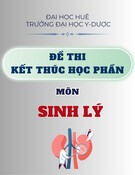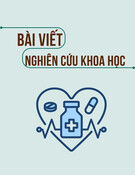
Bệnh viện Trung ương Huế
78 Journal of Clinical Medicine - Hue Central Hospital - Volume 17, number 2 - 2025
Evaluating the relationship between bone density...
Received: 10/01/2025. Revised: 05/03/2025. Accepted: 19/3/2025.
Corresponding author: Le Thi Ngoc Uyen. Email: uyenle270795@gmail.com. Phone: +84905317306
DOI: 10.38103/jcmhch.17.2.12 Original research
EVALUATING THE RELATIONSHIP BETWEEN BONE DENSITY,
OSTEOPOROSIS, AND SOME RISK FACTORS
Tran Thua Nguyen1, Le Thi Ngoc Uyen2, Phan Thi Minh Phuong3, Tran Thi Cam Tu2,
Nguyen Thi Hue2
1Internal Medicine and Geriatrics Department, Hue Central Hospital, Viet Nam
2Outpatient Department, International Medical Center, Hue Central Hospital, Viet Nam
3Department of Pathophysiology - Immunology, Hue University Of Medicine and Pharmacy, Viet Nam
ABSTRACT
Objectives: Evaluate the relationship between bone mineral density, osteoporosis, and certain risk factors such as
age, body mass index, lifestyle, glucocorticoid use in the study subjects.
Methods: A cross-sectional descriptive study was conducted on 142 elderly men who attended health check-
ups at Hue Central Hospital from April 2023 to August 2024. Bone density was measured using Dual Energy X-ray
Absorptiometry (DEXA) at three sites: lumbar spine, femoral neck, and total femur.
Results: The prevalence of osteoporosis and osteopenia was 32.4% and 38.0%, respectively. Multivariate logistic
regression analysis identified several factors significantly associated with osteoporosis. At the lumbar spine, increasing
age (OR = 1.06), smoking (OR = 5.81), physical inactivity (OR = 3.42), and glucocorticoid use (OR = 29.10) were
associated with a higher risk of osteoporosis. At the femoral neck, lower BMI (OR = 0.84 per 1 kg/m² increase) and
smoking (OR = 3.48) were significantly associated with increased osteoporosis risk.
Conclusions: Age, smoking, physical activity, BMI, and glucocorticoid use significantly affect bone density and
osteoporosis in elderly men. Older age, smoking, lack of physical activity, and glucocorticoid use are linked to low bone
density, especially at the lumbar spine. Higher BMI helps protect against osteoporosis, particularly at the femoral neck.
Early screening, lifestyle changes, and proper medication management are essential to improving bone health and
reducing fracture risk in elderly men.
Keywords: Bone density, osteoporosis, elderly men, risk factors.
I. INTRODUCTION
Osteoporosis is a musculoskeletal disease
characterized by decreased bone density and an
increased risk of fractures. Osteoporosis is a serious
health problem, affecting more than 200 million
people worldwide [1]. Numerous studies conducted
over the past 30 years show that approximately
20% of women aged 60 and older are affected
by osteoporosis, while in men of the same age,
the rate is around 10%. Osteoporosis progresses
silently without symptoms until fractures occur.
Bone fractures are the most serious consequence
of osteoporosis and one of the leading causes of
reduced lifespan. For patients who are fortunate
enough to survive a fracture, they often face
multiple complications, and their quality of life is
significantly reduced. Some patients lose the ability
to work, or their mobility is impaired, affecting
labor productivity and the economy of a nation.
It can be said that fractures due to osteoporosis
increase mortality rates, decrease lifespan, reduce
quality of life, and become a burden on healthcare
systems and national finances [2].
Men have a lower rate of osteoporosis than
women due to larger bone mass and a slower rate
of bone loss. It is estimated that for every five

Bệnh viện Trung ương Huế
Journal of Clinical Medicine - Hue Central Hospital - Volume 17, number 2 - 2025 79
Evaluating the relationship between bone density...
men over the age of 50, one will suffer a fracture
due to osteoporosis in their lifetime. In the Dubbo
Osteoporosis Epidemiology Study, the ratio of hip
fractures between men and women was 1:4.5 in the
60 - 69 age group, 1:1.5 in the 70 - 79 age group, and
1:1.9 in those aged 80 and older. Although the rate
of osteoporosis and fractures in men is lower than in
women, when fractures do occur, the mortality rate
for men is significantly higher than for women. This
difference is attributed to comorbidities and infection.
The mortality rate after a hip fracture is 10.2% in
men compared to 4.7% in women, and the 1 - year
mortality rate is 37.5% in men compared to 28.2%
in women. This risk can persist for over 10 years [3].
Elderly men are at high risk for osteoporosis and also
have many dangerous underlying health conditions.
The combination of these diseases increases the risk
of disability, decreases quality of life, and reduces
lifespan, making understanding osteoporosis in
elderly men a critical issue. This is the reason
we conducted this study titled: “Evaluating the
relationship between bone density, osteoporosis, and
certain risk factors” with the objective to evaluate the
relationship between bone density, osteoporosis, and
risk factors such as age, body mass index, lifestyle,
and glucocorticoid use in elderly men undergoing
health checks at Hue Central Hospital.
II. MATERIALS AND METHODS
2.1. Study Subjects
The study was conducted on 142 elderly male
patients who came for health check-ups at Hue
Central Hospital from April 2023 to August 2024.
Inclusion Criteria: Subjects must meet the
following conditions: Age ≥ 60 years. Male.
Exclusion Criteria: Subjects who do not agree to
participate in the study or do not have the cognitive
ability to participate. Subjects who have been or
are currently receiving treatment for osteoporosis.
Subjects who cannot measure bone density at
the femoral neck due to hip joint replacement or
bilateral femoral neck fractures, or one side has
had a hip joint replacement and the other side has a
fracture. Subjects who cannot measure bone density
at the L1-L4 vertebrae.
2.2. Research Methodology
This is a cross-sectional descriptive study using
a convenient sampling method.
- All patients underwent collection of the
following data: age, smoking history, alcohol
consumption, physical activity, medical history,
glucocorticoid use history, weight, height, blood
pressure, and BMI.
- Bone density was measured using the DEXA
method at the femoral neck, total femur, and
lumbar spine.
Table 1: Diagnostic Criteria for Osteoporosis as
Recommended by the WHO (1994) [4]
Diagnosis Criteria
Normal T-score ≥ -1
Osteopenia -2.5 < T-score < -1
Osteoporosis T-score ≤ -2.5
Severe
Osteoporosis
Osteoporosis + recent history
of fractures
III. RESULTS
3.1. Osteoporosis Prevalence in the Study Subjects
According to the WHO diagnostic criteria for
osteoporosis, when the T-score ≤ -2.5 at one of the
three measurement sites (either the lumbar spine,
femoral neck, or total femur), among the 142
study subjects, 46 patients were diagnosed with
osteoporosis, accounting for 32.4% (table2).
Table 2: Osteoporosis Prevalence According
to WHO Criteria
Bone Condition Number
(n)
Percentage
(%)
Normal 42 29.6
Osteopenia 54 38.0
Osteoporosis 46 32.4
Total 142 100
3.2. Relationship Between Bone Density and
Some Risk Factors
A significant negative correlation was observed
between age and bone mineral density (BMD) at the
femoral neck (r = -0.175; p < 0.05) (Table 3). BMI
showed a significant positive correlation with BMD
at the lumbar spine (r = 0.227; p < 0.05) (Table 4). The
mean BMD in the smoking group was significantly
lower than in the non-smoking group at both the
femoral neck and lumbar spine (p < 0.05) (Table 5).

Bệnh viện Trung ương Huế
80 Journal of Clinical Medicine - Hue Central Hospital - Volume 17, number 2 - 2025
Evaluating the relationship between bone density...
Table 3: Correlation Between Bone Density and Age
Characteristics
(n=142) BMI
Bone Density at Femoral Neck (g/cm2)
r 0.164
p > 0.05
Bone Density at Lumbar Spine (g/cm2)
r 0.227
p < 0.05
Table 5: Relationship Between Bone Density and Smoking
Characteristics
(n=142)
Smoking
p
Yes
(n=61)
No
(n=81)
Bone Density at Femoral Neck (g/cm2) 0.819 ± 0.139 0.900 ± 0.150 < 0.05
Bone Density at Lumbar Spine (g/cm2) 0.904 ± 0.181 1.064 ± 0.180 < 0.05
No significant difference in mean BMD was found between alcohol users and non-users at the femoral
neck and lumbar spine. In contrast, glucocorticoid users had significantly lower BMD, while physically
active individuals had significantly higher BMD at both sites compared to their counterparts (p < 0.05;
Tables 6 and 7).
Table 6: Relationship Between Bone Density and Glucocorticoid Use
Characteristics
(n=142)
Glucocorticoid Use
p
Yes
(n=25)
No
(n=117)
Bone Density at Femoral Neck (g/cm2) 0.793 ± 0.148 0.881 ± 0.147 < 0.05
Bone Density at Lumbar Spine (g/cm2) 0.864 ± 0.185 1.023 ± 0.189 < 0.05
Table 7: Relationship Between Bone Density and Physical Activity
Characteristics
(n=142)
Physical activity
p
Yes
(n=54)
No
(n=88)
Bone Density at Femoral Neck (g/cm2) 0.910 ± 0.146 0.838 ± 0.147 < 0.05
Bone Density at Lumbar Spine (g/cm2) 1.071 ± 0.159 0.950 ± 0.204 < 0.05
Multivariate logistic regression analysis identified two significant factors associated with osteopenia
and osteoporosis at the femoral neck: higher BMI was protective (OR = 0.84; 95% CI: 0.73 - 0.97), while
smoking increased the risk (OR = 3.48; 95% CI: 1.39 - 7.68), both with p < 0.05 (Table 8).

Bệnh viện Trung ương Huế
Journal of Clinical Medicine - Hue Central Hospital - Volume 17, number 2 - 2025 81
Evaluating the relationship between bone density...
Table 8: Multivariate Logistic Regression Model Identifying Some Factors Associated
with Osteopenia and Osteoporosis at the Femoral Neck
Factor OR 95%CI p
Age 1.01 0.96 - 1.06 > 0.05
BMI 0.84 0.73 - 0.97 < 0.05
Smoking Yes 3.48 1.39 - 7.68 < 0.05
No 1 - -
Alcohol Consumption Yes 0.87 0.42 - 3.52 > 0.05
No 1 - -
Physical activity Yes 1 - -
No 1.52 0.63 - 3.67 > 0.05
Glucocorticoid Use Yes 1.82 0.58 - 5.73 > 0.05
No 1 - -
Table 9: Multivariate Logistic Regression Model Identifying Some Factors Associated
with Osteopenia and Osteoporosis at the Lumbar Spine
Factor OR 95%CI p
Age 1.06 1.01 - 1.22 < 0.05
BMI 0.90 0.77 - 1.04 > 0.05
Smoking Yes 5.81 1.73 - 19.45 < 0.05
No 1 - -
Alcohol Consumption Yes 0.79 0.19 - 3.25 > 0.05
No 1 - -
Physical activity Yes 1 - -
No 3.42 1.28 - 9.14 < 0.05
Glucocorticoid Use Yes 29.10 3.18 - 266.35 < 0.05
No 1 - -
After multivariate logistic regression analysis, four significant factors were associated with increased risk
of lumbar spine osteopenia and osteoporosis: age (OR = 1.06; 95% CI: 1.01 - 1.22), smoking (OR = 5.81;
95% CI: 1.73 - 19.45), physical inactivity (OR = 3.42; 95% CI: 1.28 - 9.14), and glucocorticoid use (OR =
29.10; 95% CI: 3.18 - 266.35), all with p < 0.05 (Table 9).
IV. DISCUSSION
From the analysis of 142 men aged ≥ 60
years undergoing DEXA at Hue Central Hospital
(April 2023 - August 2024), 32.4% (46/142) were
diagnosed with osteoporosis according to WHO
criteria (T-score ≤ -2.5 at any site). Age was a
significant factor; each additional year increased
the risk of osteopenia and osteoporosis at the
lumbar spine by 1.06 times (OR = 1.06; 95% CI:
1.01 - 1.22; p < 0.05). This aligns with the Dubbo
study, which reported an exponential increase in hip
fracture incidence from age 75, with higher post-

Bệnh viện Trung ương Huế
82 Journal of Clinical Medicine - Hue Central Hospital - Volume 17, number 2 - 2025
Evaluating the relationship between bone density...
fracture mortality in men (twice that of women).
The MrOS study (2009) found that BMD loss at the
femoral neck in 85 - year - old men (0.021 g/cm²)
was 2.5 times greater than in 65 - year - olds (0.008
g/cm²), increasing fracture risk by 25% over 4.6
years. Men with lower baseline BMD experienced
the greatest loss during follow-up. Similarly, Yao
Fan et al. (2024) observed an age-related increase
in osteopenia and osteoporosis prevalence in men,
from 0% at age 18 to 5.43% at age 75 [5].
BMI was positively correlated with lumbar spine
BMD (r = 0.227; p < 0.05). Multivariate analysis
showed that each 1 kg/m² increase in BMI reduced
the risk of femoral neck osteopenia/osteoporosis by
0.84 times (OR = 0.84; 95% CI: 0.73 - 0.97; p <
0.05). These findings are consistent with previous
studies. According to Nguyen Van Tuan và Nguyen
Dinh Nguyen, individuals with taller stature, lower
body weight, and lower fat percentage had higher
fracture risk due to longer femoral necks and
reduced fat padding [6].
A study by Meyer et al. (2008) found BMI
positively associated with BMD 30 years later,
where weight loss increased osteoporosis risk,
while weight gain was protective. Wu (2022)
also showed underweight individuals had a 6.5
- fold higher osteoporosis risk, and overweight/
obesity had protective effects [7]. In summary,
low BMI is a risk factor, while higher BMI may
offer protection via mechanical loading and
estrogen from fat tissue, though it should not
be seen as a standalone protective factor due to
associated health risks in older adults. Smoking
was significantly associated with lower BMD
at both the femoral neck and lumbar spine (p <
0.05). Smokers had a 5.81 - fold increased risk of
lumbar spine osteopenia/osteoporosis (OR = 5.81;
95% CI: 1.73 - 19.45; p < 0.05) and a 3.48 - fold
increased risk at the femoral neck (OR = 3.48; 95%
CI: 1.39 - 7.68; p < 0.05). Similar results were
reported by In Young Cho et al. (2020), where
long-term quitters and non-smokers had lower
fracture risks (aHR = 0.83 and 0.84, respectively)
[8]. Min Fang et al. (2024) also linked smoking
to higher risks of osteoporosis (OR = 1.21) and
osteoporotic fractures: hip (OR = 1.47), wrist (OR
= 1.33), and spine (OR = 1.43) [8].
No significant association between alcohol
consumption and BMD or osteoporosis was found
in this study. However, previous literature indicates
a complex relationship. Kaptoge et al. (2003) found
that moderate alcohol consumption (1 - 2 drinks/
day) may protect bone health via increased estrogen
and reduced stress, especially in younger/middle-
aged men. In contrast, excessive alcohol intake
impairs calcium absorption, vitamin D metabolism,
and bone formation. Clarke et al. (2004) observed
reduced BMD in men > 60 with heavy alcohol use.
The MrOS Study (2009) confirmed higher BMD
in moderate drinkers and lower BMD in heavy
drinkers. Karina M. Berg et al. (2008) also found a
dose-response relationship: reduced hip fracture risk
at 0.5 - 1.0 drinks/day (RR = 0.80), but increased
risk at > 2 drinks/day (RR = 1.39) [9].
In conclusion, while moderate alcohol
consumption may not negatively affect bone health
- and may even be protective - excessive intake is
detrimental, especially in older men. Maintaining
moderate and balanced consumption is important
for bone protection with age. Glucocorticoid-
induced osteoporosis (GIOP) is the most common
secondary form of osteoporosis. Around 3% of
people over 50 and 5.2% of those over 80 have used
glucocorticoids (GC). Among long - term users (≥
6 months), 30% develop osteoporosis. Bone loss
mainly occurs in trabecular bone, particularly in the
spine and ribs. Fracture risk increases with dosage
but may improve after stopping GC use [10].
Our findings showed significantly lower BMD
in GC users and a 29.10-fold increased risk of
lumbar spine osteoporosis (OR = 29.10; 95% CI:
3.18 - 266.35; p < 0.05). Ji Weon Koh et al. (2020)
also found increased fracture risks with GC use:
vertebral fractures rose from 1.39 to 2.43 times,
and hip fractures from 1.72 to 3.28 times across
increasing GC dose levels [11]. Similarly, A study
by Ho Thi Le et al. (2023) reported a 4.92 - fold
higher lumbar spine osteoporosis risk in GC-using
rheumatoid arthritis patients.
Bone mass decreases by ~0.5% annually after
age 40, regardless of sex or ethnicity. Although
most osteoporosis studies focus on women, the
growing elderly male population highlights the
need to investigate physical activity’s role in male






















![Bài giảng Cập nhật vấn đề hồi sức bệnh tay chân miệng nặng [mới nhất]](https://cdn.tailieu.vn/images/document/thumbnail/2025/20250920/hmn03091998@gmail.com/135x160/23301758514697.jpg)



